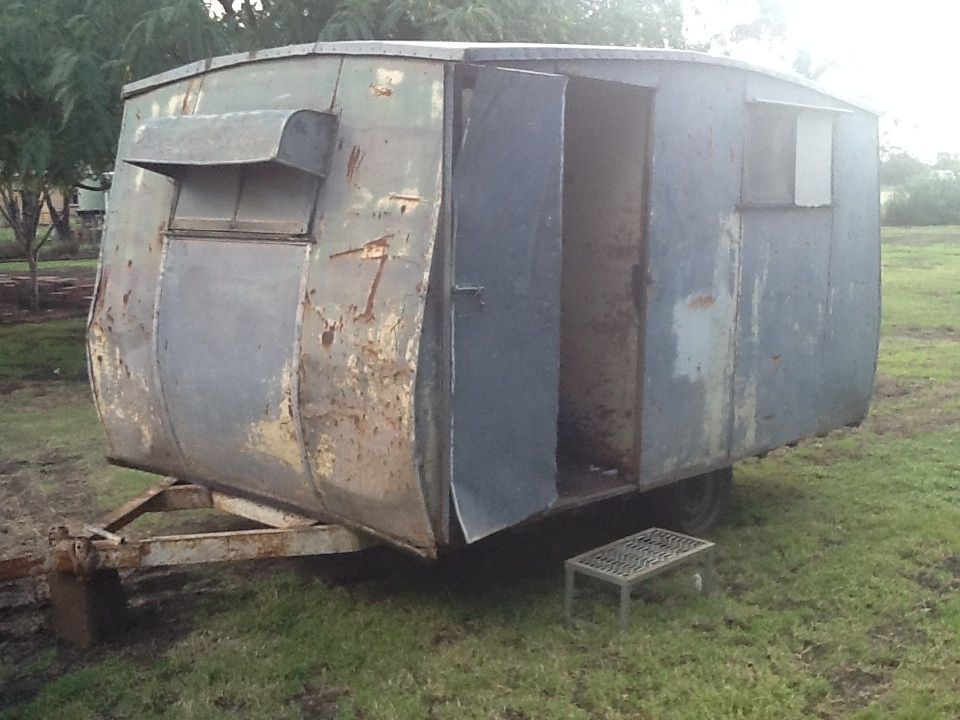|
|
Post by Don Ricardo on Feb 28, 2010 20:41:53 GMT 10
INFORMATION TRANSFERRED FROM THE 'ALUMINIUM CLADDING "LIBRARY"' AND 'PLYWOOD TRADE MARKS' THREADSOn 20 April 2009, Cobber wrote:Another method of dating... if you're lucky and have some flat iron on your 'van, mudguards, bread box, cooker surround etc... and you're very lucky and it was made by John Lysaght.... and you're very very lucky and the trade mark is visible, this information might help. 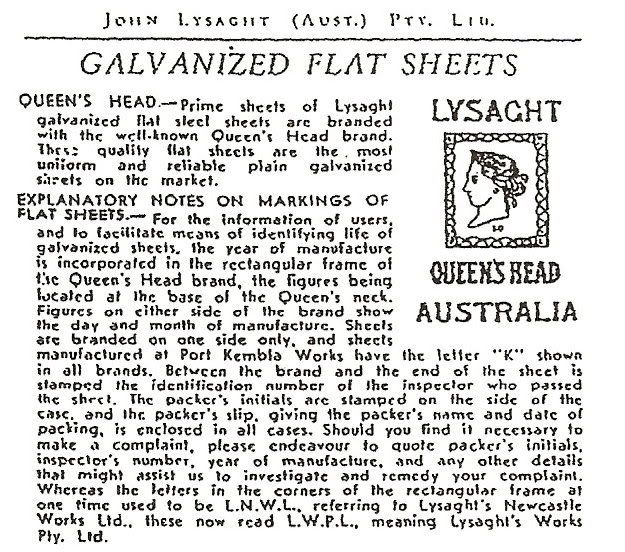 Cobber.
On 23 April 2009, Andrew wrote:Thank you Cobber me mate, Just read the piece you put in about the lysaught flat sheet and it is 9:45 pm so I grabbed the torch and headed down to the free range egg van that I still have that is clad in gal flat sheet, the one you looked at when you called in, and there on the front in the middle under the peeling paint is the Queens head and with a pick of a finger nail, there is a ..... 58 . Rather happy I am. Goes nicely with the 26th of Dec. Herald under the lino. Thanks again Cobber. Regards Andrew
Then on 15 September 2009, Bondwoodvans said:This is stamped on the back of my icebox from my previous 1951 caravan built in Newcastle 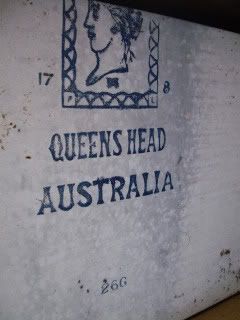 I cant make out the number under the Queens head but the number 17 and 8 are the day and month of manufacture KJL
On 1 January 2010 - no doubt inspired by the beginning of a new V V year - Roehm3108 posted:;D ;D ;D Geez cobber, you've got me doing it now. Was mucking around with an old icebox that I got hold of at the local tip, to put back into the Superb, (the original owner had ripped out the original one and replaced it with a bar fridge!!!) and when I took off all the timber crap around it, I found a trademark - not on the ply, but on the galvanised sheeting that the icebox was made out of. It's called Leopard!! Suppose now you're gonna tell me that it comes from a sixties van and shouldn't be installed into a 40's van!!!!!    Guess what cobber, it's going in anyway!!! hehehe When you get an icebox for $1, complete with intact front door and original hinges/handles, you don't care about its vintage - especially if it fits into what little gap there is!!! Ray
Cobber posted his reply on 2 January 2010:G'day Ray, Leopard brand aye? That is an exciting discovery    . That was another mark used by Lysaghts if I remember correctly  , .... but only on corrugated iron I thought so …... is your ice box made of corrugated iron, or is that brand just on the ice tray ? Under the Leopard does it have the letter “K” or “N” ? What other marks are on it Ray....... this is exciting stuff, you should put a photo of it here (another thread that gets lost over time  ) Cobber
And Roehm3108 responded on 4 January 2010 with:Hey cobber JUst for you I photographed said icebox. No, it doesn't have corrugated sides   Here's a pic, just to whet your interest a little bit more:  So, can ya tell me its age from that ;D ;D ;D Ray
At a later point Cobber replied:G'day Ray, Sorry I've been a bit slow replying to your last post. The revelation that your Leopard brand iron was NOT corrugated kind of knocked me for a six. This information I post now indicates maybe the Leopard brand was also used on Flat Mill rejects ... I dunno  Anyway..... we have shown here a method of dating the “ORB” brand corrugated sheets and the information that your ice box metal was made at Port Kembla. 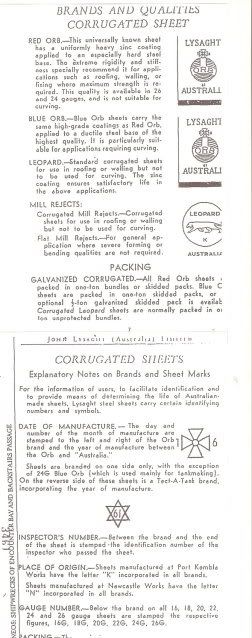 Cobber.
|
|
|
|
Post by DC3Td on Jan 12, 2011 15:08:36 GMT 10
As there is no provision for a reply in the earlier Header:
The fine print re the Leopard logo:
Standard corrugated sheets for use in roofing & walling but NOT to be used for curving.The zinc coating ensures satisfactory life in the above application.
Mill Rejects:Corrugated Mill Rejects,
Corrugated sheets for use in roofing or walling but NOT to be used in curving.
Flat Mill Rejects:
For general application where severe forming or bending qualities are not required. cheers gordon
|
|
|
|
Post by cobber on Nov 10, 2011 15:13:26 GMT 10
This piece of Orb is the sort of thing that was sometimes used as the ice tray in vintage caravan ice boxes. You would be lucky to see all of the brand markings but you might be lucky and see some of them to help determine the age of the iron or... the ice box or.... the caravan  This sample differs from the explanatory notes above in that the year mark is above the Lysaght name (in line with the "G"..not easy to see) but the information is there that this sheet was made on the 4th January 1958  . Good stuff................... aye? 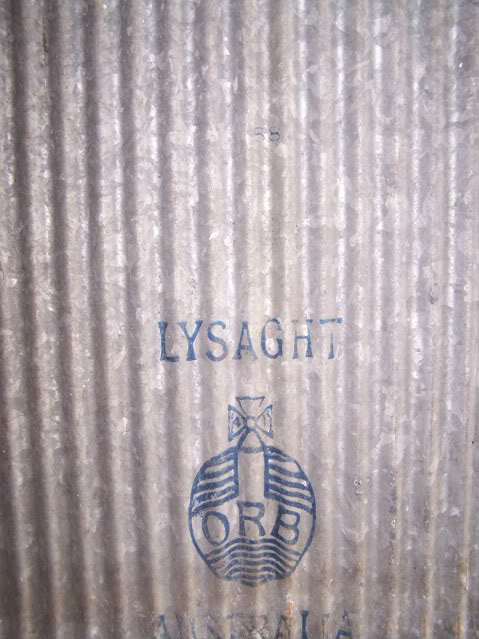 Cobber. |
|
bert68
New Member
 My old girl
My old girl
Posts: 19
|
Post by bert68 on Apr 21, 2013 19:47:39 GMT 10
Hi I have just started on my old van and found five of these  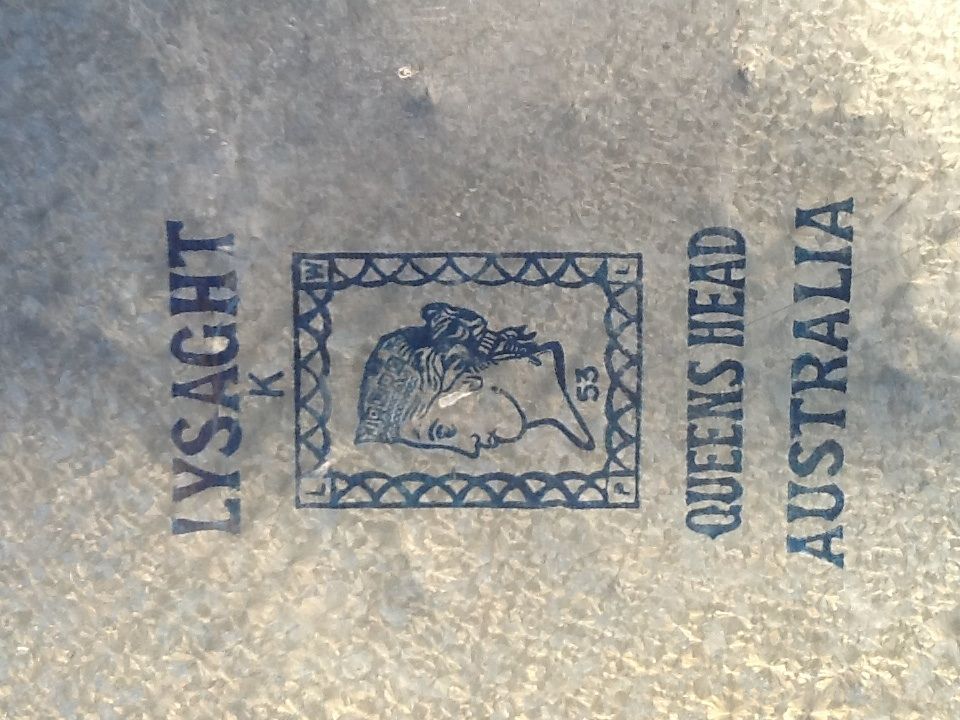 |
|
bert68
New Member
 My old girl
My old girl
Posts: 19
|
Post by bert68 on Apr 21, 2013 19:50:05 GMT 10
And here she is  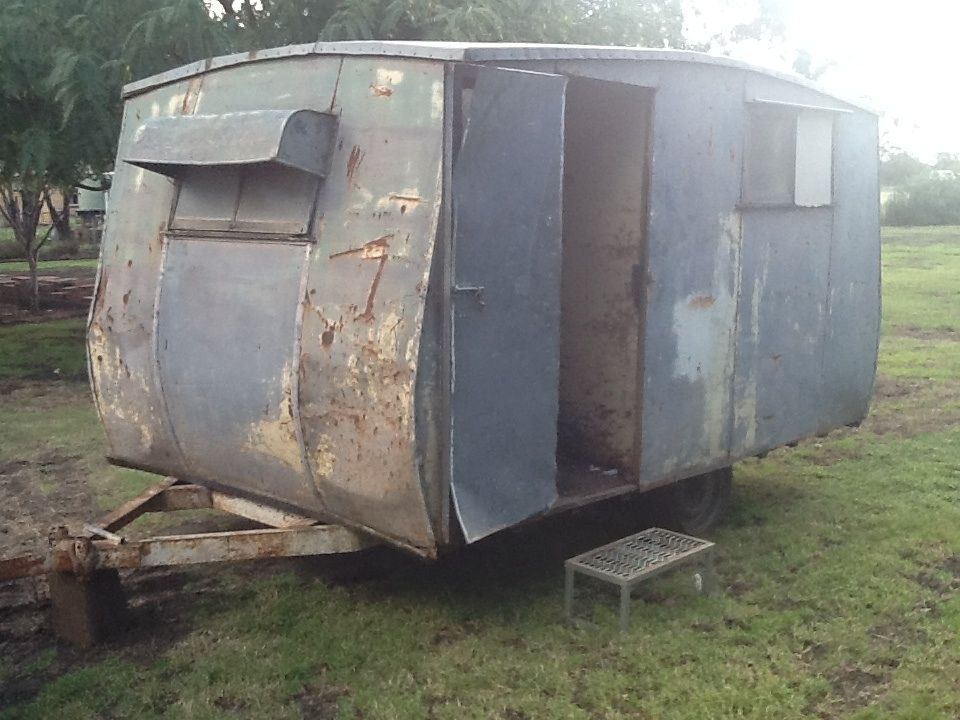 |
|
|
|
Post by cobber on Apr 21, 2013 20:32:07 GMT 10
Good on you Bert, sort of indicates the sheets were made in 1953 aye? What do you plan on doing with it, be a shame if you have to replace them. Have you found the "Tow coupling" thread yet ?, would be interesting if you could put a photo of your coupling there  Cobber. |
|
|
|
Post by Franklin1 on Jun 9, 2013 9:49:24 GMT 10
When removing the ice chest from my "1960 Newcastle" van, a Lysaght brand mark was found on the back of the chest... 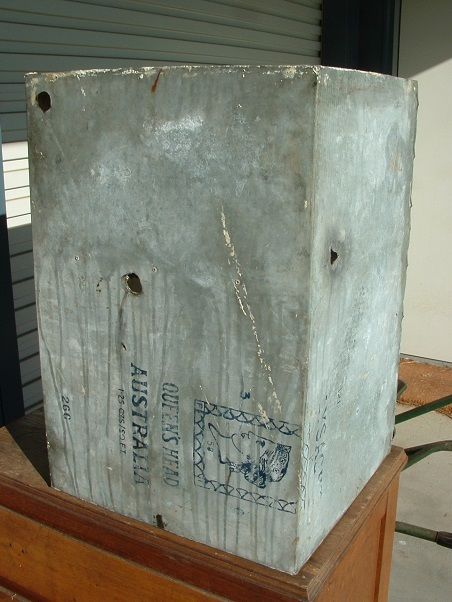 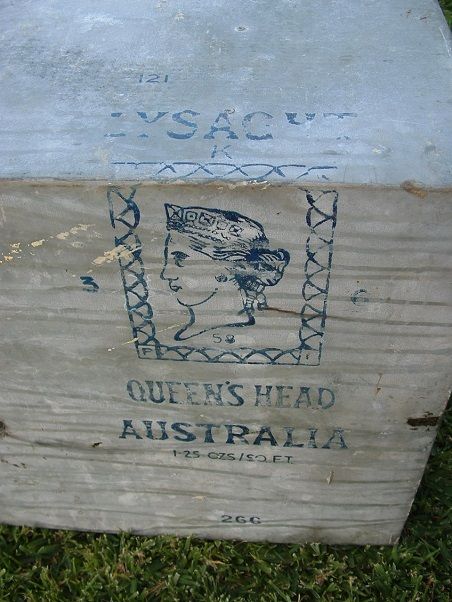 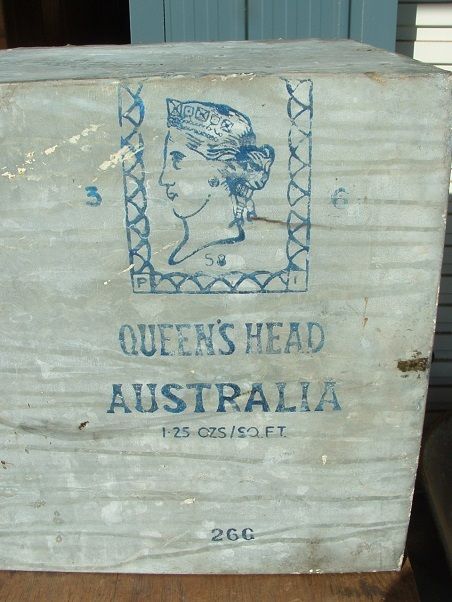 cobber cobber has decoded the manufacturing information, and I'll quote him from another thread about my van: "...a beaut piece of 26 gauge Lysaght Works Pty Ltd galvanised iron made at Port Kembla on the 3rd of June 1958..." |
|
|
|
Post by cobber on Apr 20, 2014 8:25:35 GMT 10
Another great example of a Lysaght trade mark has surfaced in this post regarding oupa's little 'Button' caravan. 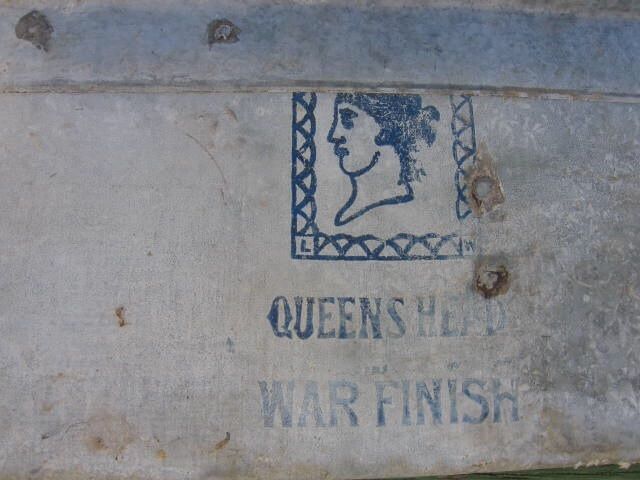 An explanation of the brand mark was found Here (thanks Geoff  ) indicating it was used on corrugated as well as flat iron. "Great find. Lysaght Orb corrugated iron manufactured in 1942 with war finish.
"To conserve stocks of TIN for Defence purposes!
TIN - normally used in the coating of Galvanized Iron - must be conserved for Government use. To meet this situation John Lysaght (Australia) Pty. Ltd. has perfected a galvanized iron sheet with a new "War Finish." Equal in quality to the familiar Orb and Queens Head Galvanized Iron as indicated by the fact that each sheet carries the well-known Lysaght guarantee - the only noticeable difference is an absence of the familiar "spangles." The public can rest assured, therefore, that in ordering and accepting Lysaght Galvanized Iron marked "War Finish" they are making a very definite contribution to the War Effort and, at the same time, securing a product that will give every service and satisfaction."Cobber. |
|
|
|
Post by akeepsake on Apr 20, 2014 9:21:53 GMT 10
Fascinating Cobber! Love your work! Just wondering what the letters represent inside each corner of the border as they are different ( or in different places) on the latest edition from Oupa's pics
Cheers Andrew
|
|
|
|
Post by cobber on Apr 20, 2014 10:48:04 GMT 10
G'day Andrew, Interesting observation you have made, would be good if the top two corners were visible.... it might then work out to be L N L W .... which might equate to 'Lysaght Newcastle Limited War'  ... just a stab in the dark on my part, seeing as you asked   That flickr site is run by a galvanised iron tragic who has a few interesting photos of iron! but I reckon we'll just concentrate on bits found on vintage caravans aye ? Cobber. |
|
|
|
Post by Nadia on Jul 20, 2014 21:55:20 GMT 10
Ive been researching Lysaght Queens Head steel sheets and L N W L Stands for Lysaghts Newcastle Works Ltd You where close!!!
|
|
|
|
Post by cobber on Jul 21, 2014 8:32:59 GMT 10
G'day Nadia, Thanks for dropping by, and you are welcome to make comment and corrections to any of the 'research' (guesses  ) that have been made on this thread. As you can see our focus is on trying to determine the age of iron found on the caravans we are restoring that, when added to other clues, might help us decide when the van was built. Any information you can contribute I'd love to see  Cobber |
|
|
|
Post by Pete Smith on Jun 11, 2016 14:18:03 GMT 10
I have just ripped of my roofing to find a stamp or two for your interest but I can't seem to add a picture to this.
Interestingly I live in Auckland NZ!
|
|
|
|
Post by Don Ricardo on Jun 13, 2016 22:54:04 GMT 10
Hi Pete Smith, Welcome to the forum. We're always pleased to hear from folk from overseas who are interested in vintage caravans.    It will be great to hear what you've discovered about the stamps on the sheeting on your van. As you've already found out, unfortunately you can't post photos on the forum using the 'Add Attachment' button - it doesn't function on this forum (long story!). To post photos here you need to do it via an online photo storage website such as Photobucket or Flickr. There are instructions on how to do it in the 'Forum Guidelines & Helpful Hints' section of the forum. Give us a shout if you have trouble working out what to do, and we'll try and help you. I note that you have currently posted as a Guest. To post photos, you may need to register as a forum member. We'll be interested to hear about your van as well as the stamps on the sheeting. Don Ricardo |
|
|
|
Post by Leo on Apr 24, 2017 15:56:01 GMT 10
Does anyone know exactly what the "war" finish was if it's not tin?
|
|
|
|
Post by cobber on Apr 24, 2017 17:47:03 GMT 10
G'day Leo, I think you might be refferng to the earlier post on this thread that quotes a statement found on a Flickr account that states that Lysaght suspended the use of tin as a galvanising agent during the war. The original statement can be seen HEREI'm not sure that statement is correct. I would have thought it would have been the use of zinc that was suspended during the war by Lysaght, maybe it was replaced by tin ? Maybe somebody who knows what they are talking about can contribute to this discussion   Cobber. |
|
|
|
Post by Franklin1 on Apr 24, 2017 23:45:51 GMT 10
G'day cobber, Yeah, I think the Flickr information is a bit "corrupted". Galvanised iron has always had a zinc coating. Tin would never stand up to the harsh Aussie climate and would corrode away pretty quickly. Tin is great for coating the steel used in food cans, paint tins, etc, which have a fairly short lifespan and are then disposed of. I think what the Flickr poster was really trying to say was that the zinc coating applied during the war was dulled down and wasn't as highly reflective as the normal galvanised sheeting (hence the poster's reference to "the only noticeable difference is an absence of the familiar " spangles." (my underlining). You wouldn't want a row of bright house roofs showing the enemy exactly where to target their bombs, would you?!  cheers, Al. (36 years at the Port Kembla steelworks; retired 10 years now and loving it...)  |
|
|
|
Post by Paulyk on Jan 30, 2018 14:47:51 GMT 10
Has anyone heard of a corrugated iron brand called Vincent Best?? It has a picture of a crown on it. Can't find any reference to it.
|
|
|
|
Post by cobber on Jan 31, 2018 11:44:12 GMT 10
G'day Paulyk, Is there any chance the brand on your corrugated iron actually reads "St Vincent's" ? If so there is some information on Wikipedia regarding John Lysaght starting at the "St Vincent's Works" in the U.K. in 1857. See here, en.m.wikipedia.org/wiki/Lysaght_(Australian_company)And here, en.m.wikipedia.org/wiki/St_Vincent%27s_WorksI don't know if their iron, or the previous owner Acraman and Company ever branded the iron "Vincent brand" but it sounds like a possibility to me, more research needed. Where did you find your sample, does it look ancient, can you post a photo please ? 😉 Cobber. |
|
|
|
Post by cyberbutterfly on Mar 16, 2018 21:36:40 GMT 10
May i ask how to look up dating tin/steel sheets from USA /phoenix ....
|
|
|
|
Post by BlowMeDown on Apr 19, 2019 17:59:14 GMT 10
I'm not sure this is 100% correct although the description in the Flickr comments is quoted so I assume it's official. If I may deviate for a moment, the reason I'm here isn't related to caravans but this thread has put me on the right path. I'm trying to date some undated "Queen's Head" AUSTRALIA sheet marked [??WL], which I assume is [LNWL]. Interestingly my piece is soldered to another piece of "Queen's Head" SPECIAL FLAT marked [JLBL], so that would date the fabricated item between 1921 and 1924 (earliest Australian sheet 1921 and last known imported sheet 1924). Back to the purpose of my contribution here, according to an article in the Kalgoorlie Miner of 3 July 1941, the WAR FINISH sheets are in fact terne coated (lead and tin alloy), introduced to conserve zinc for the war effort. Here's the link: trove.nla.gov.au/newspaper/article/95128511?searchTerm=%22queen%27s%20head%22%20and%20lysaght&searchLimits=The date on the article (July 1941) may also provide an earliest date on these undated sheets. Another great example of a Lysaght trade mark has surfaced in this post regarding oupa's little 'Button' caravan.  An explanation of the brand mark was found Here (thanks Geoff  ) indicating it was used on corrugated as well as flat iron. "Great find. Lysaght Orb corrugated iron manufactured in 1942 with war finish.
"To conserve stocks of TIN for Defence purposes!
TIN - normally used in the coating of Galvanized Iron - must be conserved for Government use. To meet this situation John Lysaght (Australia) Pty. Ltd. has perfected a galvanized iron sheet with a new "War Finish." Equal in quality to the familiar Orb and Queens Head Galvanized Iron as indicated by the fact that each sheet carries the well-known Lysaght guarantee - the only noticeable difference is an absence of the familiar "spangles." The public can rest assured, therefore, that in ordering and accepting Lysaght Galvanized Iron marked "War Finish" they are making a very definite contribution to the War Effort and, at the same time, securing a product that will give every service and satisfaction."Cobber. |
|
|
|
Post by BlowMeDown on Apr 19, 2019 20:20:16 GMT 10
Adding to my previous post, unless I am utterly confused by this other article in the Manilla Express (NSW) a year later, which to me is as clear as mud, the Kalgoorly Miner article the year before (or more likely Lysaght's press release at the time) was somewhat misleading: trove.nla.gov.au/newspaper/article/196292204?searchTerm=%22queen%27s%20head%22%20and%20lysaght&searchLimits=it appears the WAR FINISH is still a zinc finish (with less tin in it and a duller appearance) for use in drinking water storage etc. while the terne coated sheets are not marked WAR FINISH and are for building purposes etc and definitely not ok for water or food storage (containing lead). There, glad that's all clear now. |
|
|
|
Post by BlowMeDown on Apr 19, 2019 21:07:23 GMT 10
|
|
|
|
Post by cobber on Apr 20, 2019 13:01:48 GMT 10
G'day BlowMeDown,
Thanks for your contributions to this thread & I'm pleased it has been of some use to you. What type of project are you working on ? ....dateing and finding appropriate parts and fittings can be half the fun so far as some of we vintage caravan nuts are concerned 😉
Cobber
|
|
|
|
Post by Sam Worner on Jul 16, 2020 15:35:48 GMT 10
Has anyone heard of a corrugated iron brand called Vincent Best?? It has a picture of a crown on it. Can't find any reference to it. Hey mate, I’m a builder in Hillston, NSW. We have an 1800’s wool shed here with this stamp on it and I’ve never seen it anywhere else. I also cannot find any reference to this. |
|







 .
. , .... but only on corrugated
, .... but only on corrugated  )
)











 .
. , .... but only on corrugated
, .... but only on corrugated  )
)








 .
.

